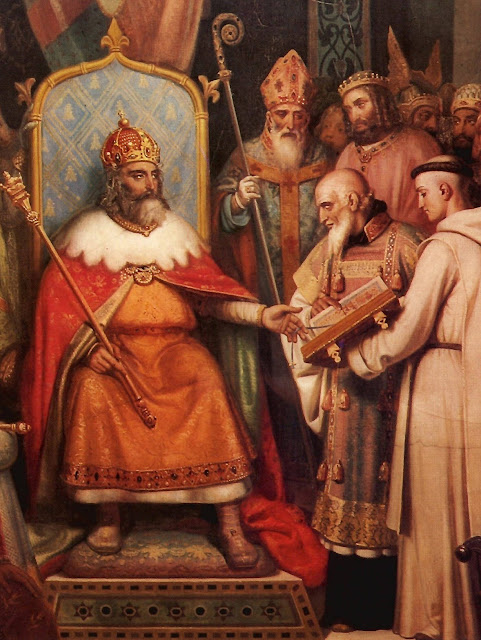(Charlemagne at Alcuin, painted 1830, at the Louvre, [Public Domain]
via Creative Commons)
When you think of medieval
Europe, two words often come to the forefront of the mind—Charlemagne and
feudalism. The empire created by Charlemagne, however, was not governed by a
feudal system, at least not in the way most people imagine.
First of all, we have to
define feudalism. Broadly speaking, a king used a feudal system when he
delegated to underlings varying amounts of autonomy to rule portions of the kingdom.
Feudal lords can also be called ‘banal lordships’ because of the monarch’s
authority (or bannus) that local lords siphoned from the king in order to rule
their lands, such as dukedoms or counties. Claiming to rule their territory in
the name of the king, these lords claimed ownership of the resources in their
lands, allowing them to set up monopolies on goods production and agriculture
in their specific domains.
The key points of feudalism,
however, are delegation and decentralization—and these are traits that are hard
to find in the empire created by Charlemagne. He simply did not delegate enough
of his power for his government to be adequately labeled as feudal. Sure,
Charlemagne granted his trusted followers titles such as ‘vice-count’ and
‘judge,’ but there is little to no evidence that suggests any of these
officials labeled themselves as ‘lords.’ During Charlemagne’s time, power
remained firmly centralized in the hands of the monarch.
It was only after
Charlemagne, around the 10th and 11th centuries, that kings began to lose their
grip (just like the weak Merovingian kings that preceded Charlemagne's own dynasty) over the banal lords that governed the kingdoms. As the power of the kings
weakened and decentralized, the autonomy and independence of local lords
strengthened. These autonomous, powerful lordships held together loosely by a
decentralized monarchy were the true feudal lords of the Middle Ages.
Written by C. Keith Hansley.
- Introduction to Medieval Europe, 300-1500 (Second Edition) by Wim Blockmans and Peter Hoppenbrouwers. New York: Routledge, 2014.
- https://www.britannica.com/topic/feudalism

No comments:
Post a Comment